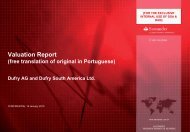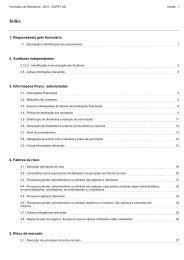DUFRY AG Listing of 4,218,750 Registered Shares
DUFRY AG Listing of 4,218,750 Registered Shares
DUFRY AG Listing of 4,218,750 Registered Shares
Create successful ePaper yourself
Turn your PDF publications into a flip-book with our unique Google optimized e-Paper software.
Seasonality<br />
Further, and irrespective <strong>of</strong> the prevailing economic climate, passenger flows and the Dufry Group’s sales<br />
are seasonal. Such seasonality, however, varies from region to region. In Europe, for example, the highest levels<br />
<strong>of</strong> sales and pr<strong>of</strong>its are during the months <strong>of</strong> July and August, while in the Central and South Americas and the<br />
Caribbean the highest levels <strong>of</strong> sales and pr<strong>of</strong>its are during December and in the USA from June to August. In<br />
addition, certain seasonal events affecting sales, such as Easter or Ramadan, occur on different dates each year.<br />
As Dufry increases its working capital prior to these peak sales periods to carry higher inventory levels and<br />
increase its sales staff levels to meet anticipated demands, its results <strong>of</strong> operations would be affected negatively<br />
by any substantial decrease in sales during the traditional peak selling periods.<br />
Currency Fluctuations<br />
The Dufry Group benefits from natural hedging to a large extent, as its sales are primarily in Euros or US<br />
dollars and its cost <strong>of</strong> goods and concession payments are also primarily denominated in Euros or US dollars. In<br />
addition, concession fees are largely linked to sales. The Dufry Group’s results may, however, be positively or<br />
negatively affected by currency fluctuations as it reports in Swiss Francs. However, the impact on pr<strong>of</strong>itability is<br />
generally limited. See, further, “—Risk Management—Foreign Exchange Risk.”<br />
Depreciation and Amortization<br />
Dufry’s depreciation and amortization policies may also affect its pr<strong>of</strong>itability. The Dufry Group<br />
depreciates property, plant and equipment on a straight line basis over the shorter <strong>of</strong> the useful life <strong>of</strong> the asset<br />
(eg, four years for furniture and 10 years for fittings and other leasehold improvements) or the life <strong>of</strong> the<br />
concession to which the assets relate. Intangible assets with finite lives are amortized over the useful economic<br />
life and assessed for impairment whenever there is an indication that the intangible asset may be impaired.<br />
Intangible assets with indefinite useful lives are tested for impairment annually either individually or at the cashgenerating<br />
unit level and are also reviewed annually to determine whether indefinite life assessment continues to<br />
be supportable. If not, the change in useful life assessment from indefinite to finite is made on a prospective<br />
basis. Intangibles with indefinite useful lives are not amortized.<br />
Financial Result<br />
The Dufry Group’s pr<strong>of</strong>itability may be affected by the net amount <strong>of</strong> interest paid, interest earned, foreign<br />
exchange gains or losses from foreign exchange translation effects and gains or losses from the sale <strong>of</strong><br />
subsidiaries.<br />
Income Taxes<br />
Tax expense is based on the operating pr<strong>of</strong>it and net financial income and expenses <strong>of</strong> the Dufry Group on a<br />
separate return basis, ie, each subsidiary is taxed in its jurisdiction <strong>of</strong> operation, including financial income and<br />
expenses arising from inter-company financing in the Dufry Group. Tax losses carried from one tax period to<br />
the next may also influence the Dufry Group’s tax expense. As a result, there are substantial differences in tax<br />
rates across the Dufry Group. However, Dufry has put in place a standardized tax planning system across the<br />
Dufry Group whereby certain Dufry Group costs may be charged back to the Dufry Group’s operating<br />
subsidiaries based on clearly defined parameters through management fees, logistics costs and franchise fees<br />
determined on an arm’s length basis.<br />
Minorities<br />
Dufry’s business model places importance on the involvement <strong>of</strong> local partners in its concessions. See<br />
“Business—Business Strategy—Position Dufry as preferred partner for long-term business relationships.” While<br />
the Dufry Group benefits from the contribution that a local partner brings to the operation <strong>of</strong> a concession, the<br />
involvement <strong>of</strong> such partners in the ownership <strong>of</strong> the Company’s operating subsidiaries reduces the net earnings<br />
<strong>of</strong> the Dufry Group. For example, 40 percent <strong>of</strong> one <strong>of</strong> the Company’s main European operating subsidiaries,<br />
Dufrital, is owned by Milan’s airport authority, the Società Esercizi Aeroportuali SpA; 49 percent <strong>of</strong> the Dufry<br />
Group’s operating subsidiary at Sharjah is owned by the Sharjah Civil Aviation Authority; 49 percent <strong>of</strong> DSA is<br />
publicly held; and 40 percent <strong>of</strong> the Company’s subsidiary, Duty Free Caribbean, is owned by its local partner<br />
Cave Shepherd & Co, one <strong>of</strong> the longest established trading companies in Barbados. The Dufry Group’s interest<br />
in the earnings <strong>of</strong> these operating subsidiaries is therefore significantly reduced.<br />
25





